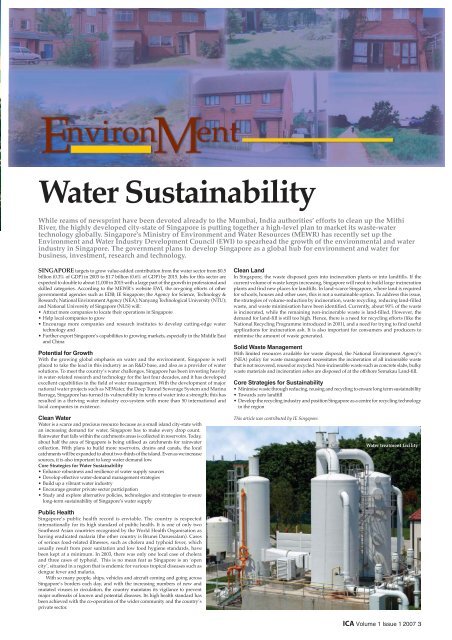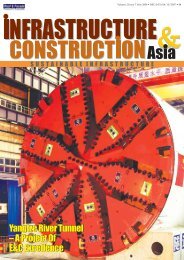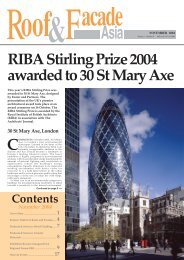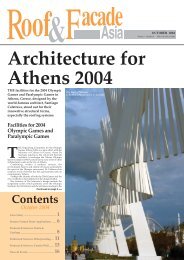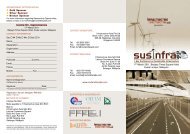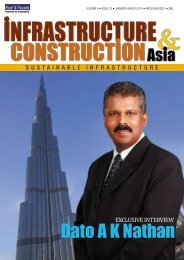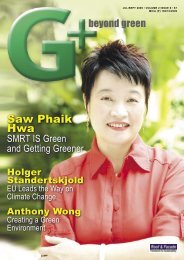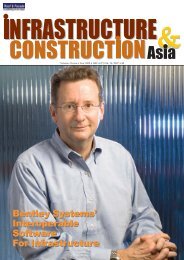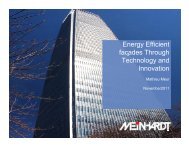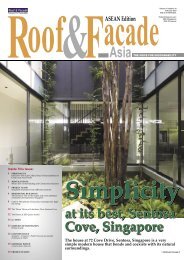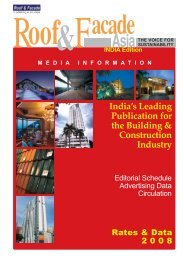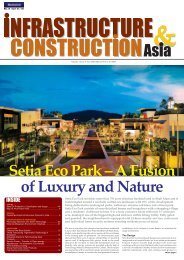ICA_Feb 07.pdf - Roof & Facade
ICA_Feb 07.pdf - Roof & Facade
ICA_Feb 07.pdf - Roof & Facade
Create successful ePaper yourself
Turn your PDF publications into a flip-book with our unique Google optimized e-Paper software.
Water Sustainability<br />
While reams of newsprint have been devoted already to the Mumbai, India authorities’ efforts to clean up the Mithi<br />
River, the highly developed city-state of Singapore is putting together a high-level plan to market its waste-water<br />
technology globally. Singapore’s Ministry of Environment and Water Resources (MEWR) has recently set up the<br />
Environment and Water Industry Development Council (EWI) to spearhead the growth of the environmental and water<br />
industry in Singapore. The government plans to develop Singapore as a global hub for environment and water for<br />
business, investment, research and technology.<br />
SINGAPORE targets to grow value-added contribution from the water sector from $0.5<br />
billion (0.3% of GDP) in 2003 to $1.7 billion (0.6% of GDP) by 2015. Jobs for this sector are<br />
expected to double to about 11,000 in 2015 with a large part of the growth in professional and<br />
skilled categories. According to the MEWR’s website EWI, the on-going efforts of other<br />
governmental agencies such as EDB; IE Singapore; the Agency for Science, Technology &<br />
Research; National Environment Agency (NEA); Nanyang Technological University (NTU);<br />
and National University of Singapore (NUS) will:<br />
• Attract more companies to locate their operations in Singapore<br />
• Help local companies to grow<br />
• Encourage more companies and research institutes to develop cutting-edge water<br />
technology and<br />
• Further export Singapore’s capabilities to growing markets, especially in the Middle East<br />
and China<br />
Potential for Growth<br />
With the growing global emphasis on water and the environment, Singapore is well<br />
placed to take the lead in this industry as an R&D base, and also as a provider of water<br />
solutions. To meet the country’s water challenges, Singapore has been investing heavily<br />
in water-related research and technology for the last four decades, and it has developed<br />
excellent capabilities in the field of water management. With the development of major<br />
national water projects such as NEWater, the Deep Tunnel Sewerage System and Marina<br />
Barrage, Singapore has turned its vulnerability in terms of water into a strength; this has<br />
resulted in a thriving water industry eco-system with more than 50 international and<br />
local companies in existence.<br />
Clean Land<br />
In Singapore, the waste disposed goes into incineration plants or into landfills. If the<br />
current volume of waste keeps increasing, Singapore will need to build large incineration<br />
plants and find new places for landfills. In land-scarce Singapore, where land is required<br />
for schools, houses and other uses, this is not a sustainable option. To address this issue,<br />
the strategies of volume-reduction by incineration, waste recycling, reducing land-filled<br />
waste, and waste minimisation have been identified. Currently, about 90% of the waste<br />
is incinerated, while the remaining non-incinerable waste is land-filled. However, the<br />
demand for land-fill is still too high. Hence, there is a need for recycling efforts (like the<br />
National Recycling Programme introduced in 2001), and a need for trying to find useful<br />
applications for incineration ash. It is also important for consumers and producers to<br />
minimise the amount of waste generated.<br />
Solid Waste Management<br />
With limited resources available for waste disposal, the National Environment Agency’s<br />
(NEA) policy for waste management necessitates the incineration of all incinerable waste<br />
that is not recovered, reused or recycled. Non-incinerable waste such as concrete slabs, bulky<br />
waste materials and incineration ashes are disposed of at the offshore Semakau Land-fill.<br />
Core Strategies for Sustainability<br />
• Minimise waste through reducing, reusing and recycling to ensure long term sustainability<br />
• Towards zero landfill<br />
• Develop the recycling industry and position Singapore as a centre for recycling technology<br />
in the region<br />
Clean Water<br />
Water is a scarce and precious resource because as a small island city-state with<br />
an increasing demand for water, Singapore has to make every drop count.<br />
Rainwater that falls within the catchments areas is collected in reservoirs. Today,<br />
about half the area of Singapore is being utilised as catchments for rainwater<br />
collection. With plans to build more reservoirs, drains and canals, the local<br />
catchments will be expanded to about two-thirds of the island. Even as we increase<br />
sources, it is also important to keep water demand low.<br />
Core Strategies for Water Sustainability<br />
• Enhance robustness and resilience of water supply sources<br />
• Develop effective water-demand management strategies<br />
• Build up a vibrant water industry<br />
• Encourage greater private sector participation<br />
• Study and explore alternative policies, technologies and strategies to ensure<br />
long-term sustainability of Singapore’s water supply<br />
Public Health<br />
Singapore’s public health record is enviable. The country is respected<br />
internationally for its high standard of public health. It is one of only two<br />
Southeast Asian countries recognised by the World Health Organisation as<br />
having eradicated malaria (the other country is Brunei Darussalam). Cases<br />
of serious food-related illnesses, such as cholera and typhoid fever, which<br />
usually result from poor sanitation and low food hygiene standards, have<br />
been kept at a minimum. In 2003, there was only one local case of cholera<br />
and three cases of typhoid. This is no mean feat as Singapore is an ‘open<br />
city’, situated in a region that is endemic for various tropical diseases such as<br />
dengue fever and malaria.<br />
With so many people, ships, vehicles and aircraft coming and going across<br />
Singapore’s borders each day, and with the increasing numbers of new and<br />
mutated viruses in circulation, the country maintains its vigilance to prevent<br />
major outbreaks of known and potential diseases. Its high health standard has<br />
been achieved with the co-operation of the wider community and the country’s<br />
private sector.<br />
This article was contributed by IE Singapore.<br />
Water treatment facility<br />
<strong>ICA</strong> Volume 1 Issue 1 2007 3


